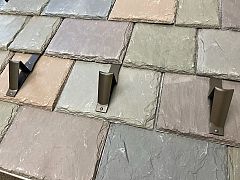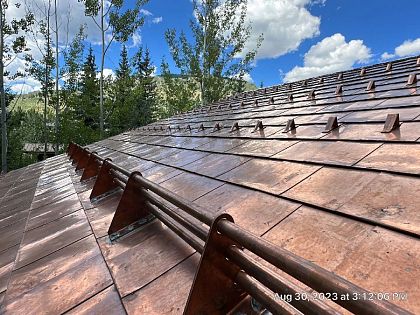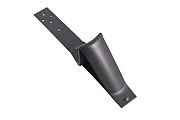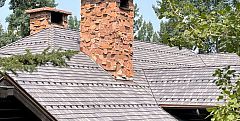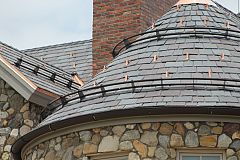"These are the soldiers on the roof," says RMSG President, Lars Walberg. "Our research shows that, when specifically placed 12 inches apart horizontally, snow guards are most effective in holding snow."
"Additionally, we've researched the vertical distance between the soldier rows. Depending on the pitch and snow load, it turns out that those distances can be quite large, as long as the soldier rows have snow guards placed every 12 inches on center horizontally within rows. This is because the close 12-inch spacing acts more like a barrier than the friction of a traditional spread pattern. It's so effective that the soldier row pattern is now considered the 'standard' pattern for us."
Based in Colorado, we offer a wide variety of snow guards, including Snow Trapper (ST), Rocky Guard (RG) and Yeti styles. These snow guards can all be installed in the soldier row pattern and are specified for all types of roofing including composite, metal, asphalt and concrete throughout the United States.
Soldiering On
In the Midwest, Richards Building Supply® is a stocking distributor of Rocky Mountain Snow Guards' products. Since 2016 the company has used the powder coated steel Rocky Guard series snow guards.
"Our snow in the Midwest has more moisture content than in other regions," says Tony Abate, branch manager with Richards Building Supply out of Itasca, Illinois. "The soldier row pattern causes the dense snow to wedge and hold between the snow guards. This allows the snow to melt out underneath, while keeping the snow sheet in place."
"We've found the soldier row pattern is very effective, especially when installed on composite roofing, like DaVinci Roofscapes™. Our advice is that every project use this pattern for snow guards on the entire roof."
Advantages for Installers & Homeowners
Across the state of Colorado, the installation team at Umbrella Roofing began using the soldier row as soon as it was introduced. Josh Yandle, with the award-winning company, endorses the idea of installing the snow guards up the full roof.
"When you hold the snow evenly throughout the roof there's less opportunity for sections to slide down into pinch-points," says Yandle. "Then you have a much more consistent and even melt-off. This allows the gutters and heat cable to keep up with the melting as it warms up and reduces large ice accumulation on sections lower down the roof."
From an installation standpoint, Yandle is a fan of the soldier row pattern for several reasons. "First, the finished project is aesthetically pleasing to homeowners," says Yandle. "The roof looks a lot less busy. With the right layouts the soldier row pattern can add to the finished product rather than distract from it."
"Second, from a bidding standpoint, it's much easier for me to get accurate numbers on a layout rather than using averages. Next, on the installation side, my guys move faster installing the soldier row pattern. They're not having to constantly snap chalk lines and pause to check layout patterns. When you are installing one snow guard every foot, it's a smoother, more instinctive installation rather than pausing every three feet by three rows or something like that. It becomes a fluid part of the install."
5-Star Dependability
After starting in the snow retention industry in 2010, Lars Walberg watched for years as roofers relied on the old "spread" pattern of snow guard installation. His analysis showed problems with placing snow guards with larger gaps between rows on low snow load and low pitch areas of the roof, along with smaller gaps for higher loads and steeper pitches.
"We've found that installing rows up the whole roof, in the soldier row pattern, greatly eliminates the buildup of snow in valleys, reducing the potential for avalanching," says Walberg. "And, even though it seems unlikely, oftentimes it takes fewer snow guards in the soldier row pattern than in the spread pattern to achieve effective snow retention.
"We strive to provide the best snow guard options with the installation pattern most guaranteed for success with snow retention. Both give dependability and peace-of-mind to the installers and homeowners."



